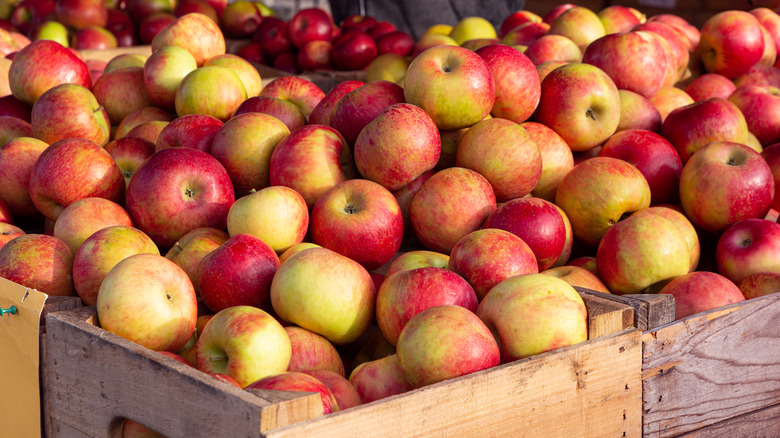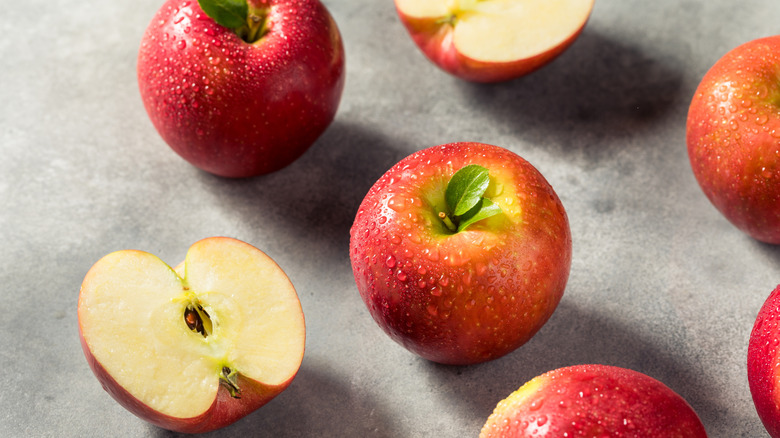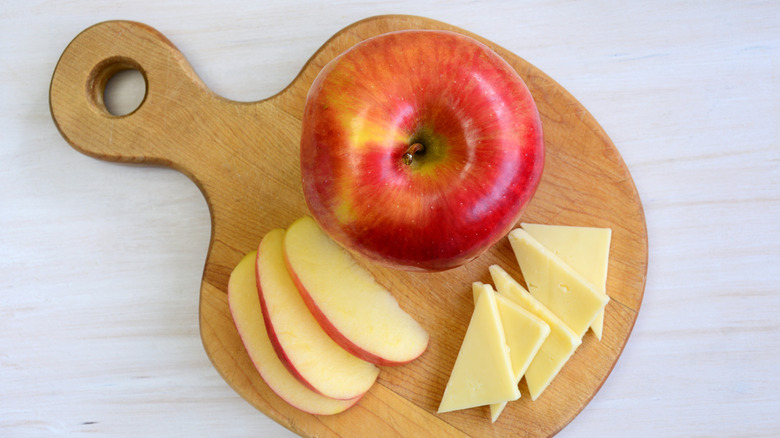What Makes Honeycrisp And Cosmic Crisp Apples Different?
If you're a true apple connoisseur, you know there is more than the choice of just green and red. Beyond the handful of apple varieties in the standard supermarket, there are over 7,500 apple varieties grown throughout the world. Some varieties are tart and acidic while others are juicy and sweet — and if you like the latter flavor, Honeycrisp and Cosmic Crisp apples should be on your radar.
To understand how these two apples are different, we'll first break down their similarities. Both apple varieties, and all other types, belong to the Rosaceae family. Both are celebrated for their high level of sweetness and juiciness, low levels of acid, as well as almost always having a dependable crunchy flesh. Cosmic Crisp's crunchy bite and sweetness is actually thanks to the Honeycrisp apple — this apple variety is the result of breeding Honeycrisp with Enterprise apples.
Cosmic Crisp and Honeycrisp can be considered younger apple varieties — heirloom apple varieties, like Pippin and Baldwin, were discovered in the 1700s and 1800s. The brand new Cosmic Crisp was first introduced in 2019, after taking 20 years to breed correctly. Honeycrisp has had a bit more time on the market — it was released in 1992, and it took 10 years longer to develop than the Cosmic Crisp. And if you're wondering if these apples are GMO, neither are. Apple breeding does not involve genetic engineering, but is completed through selection for specific traits and crossbreeding between varieties.
What are Cosmic Crisp apples?
The first noticeable difference between the two apple varieties is the outer skin – Cosmic Crisp is a deeper, true red color that is similar to the skin of a red delicious apple. With a medium to large size and a round shape, it has the classic red apple look that is often represented in drawings and emojis. While "crisp" comes from its Honeycrisp parent, the "cosmic" denotation comes from the white speckles (also known as lenticels) that are reminiscent of a starry constellation. While both apple varieties are juicy and sweet, Cosmic Crisp has more of a balance between sweet and tart, but with no mouth-puckering sourness.
If Honeycrisp is already an amazing apple, why was the Cosmic Crisp developed? The two apple varieties share many of their flavor and texture attributes, but Cosmic Crisp was developed to create a long-lasting apple. When kept in commercial cold storage, it can last up to a year. Plus, when sliced, it is not supposed to brown as quickly as other apple varieties.
Cosmic Crisp was developed at Washington State University, and for the time being, it is only licensed to be grown by a few orchards in Washington and Italy to prevent competition against the apple-growing state. This boutique apple is typically a bit more expensive than other varieties, with a price of $2.44 per pound; the Honeycrisp price has dropped this year and is still sold at an average price of $1.70 per pound.
Honeycrisp: The original crunch
The Honeycrisp apple, also called Honeycrunch in Europe, is almost always one of the biggest ones you'll find in the grocery store. Now the state fruit of Minnesota, this large, round apple has a thin skin with a coloring of reddish pink and green-yellow streaking. Compared to other apples, Honeycrisp has a larger cell structure that contributes to the crunchy texture, and larger pieces of the flesh to break off when biting into it. The prominent tasting notes are mostly sweet and juicy with a subtle tanginess.
The original intention behind creating the Honeycrisp apple was to develop an apple tree that would be able to survive through Minnesota's harsh, cold winter, and it was successfully bred by the University of Minnesota's Agricultural Experiment Station. The origins of the apple are a bit murkier than the Cosmic Crisp, as it is a combination between a Keepsake apple and an unnamed variety. It continues to be grown in Minnesota, as well as in colder regions in the United States and throughout the world.
Today, Honeycrisp is one of the most cultivated apples in the entire world, and its popularity took off on its own, without any of the marketing support that the flashy new Cosmic Crisp has. For context, $11 million was spent to build the Cosmic Crisp brand, while the new attributes that Honeycrisp brought to the market, like being crunchy instead of mealy, helped it naturally gain traction over a few years.
Culinary applications of Honeycrisp vs Cosmic Crisp
There is no question that both of these are perfect for eating as they are. Sliced and plain, served alongside cheese or a dollop of peanut butter, both of these apple varieties make for an excellent snack in their uncooked form. Incorporate the sweet, crunchy texture sliced thin for a sandwich, or cubed for a salad. When stored in the refrigerator, this enhances the existing crispy, crunchiness of the apples and also helps extend their lifespan.
When it comes to baking, there will be some variation between the varieties. When you need a firm apple that maintains its shape after baking, Honeycrisp is ideal. It stands up well to heat when incorporated into pies, cobblers, and dumplings, so you'll still have a solid shape from the apple slices or cubes, but breaks down just enough for a pie filling. The natural sweetness is perfect for any apple dessert.
Because Cosmic Crisp hasn't been around as long as some of the other better-known apples, it hasn't reached the ranks of the Granny Smith or Honeycrisp in the baking world. Because it is a crunchy, crisp apple, it would also work well for holding its shape in an apple pie or cobbler. It can become slightly more tart when cooked, so more sugar may be needed when baking with it compared to the Honeycrisp. The balance of sweet and tart makes it a good candidate for savory dishes, too, with sautéed greens, pork chops, or sausage.



